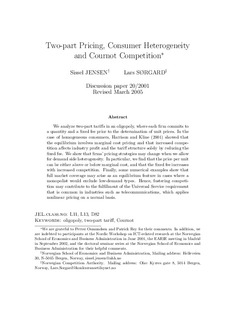Two-part pricing, consumer heterogeneity and Cournot competition
Working paper
Permanent lenke
http://hdl.handle.net/11250/162714Utgivelsesdato
2001Metadata
Vis full innførselSamlinger
- Discussion papers (SAM) [657]
Sammendrag
We analyze two-part tariffs in an oligopoly, where each firm commits to
a quantity and a fixed fee prior to the determination of unit prices. In the
case of homogeneous consumers, Harrison and Kline (2001) showed that
the equilibrium involves marginal cost pricing and that increased competition
affects industry profit and the tariff structure solely by reducing the
fixed fee. We show that firms’ pricing strategies may change when we allow
for demand side heterogeneity. In particular, we find that the price per unit
can be either above or below marginal cost, and that the fixed fee increases
with increased competition. Finally, some numerical examples show that
full market coverage may arise as an equilibrium feature in cases where a
monopolist would exclude low-demand types. Hence, fostering competition
may contribute to the fulfillment of the Universal Service requirement
that is common in industries such as telecommunications, which applies nonlinear pricing on a normal basis.
Beskrivelse
Revised March 2005
Utgiver
Norwegian School of Economics and Business Administration. Department of EconomicsSerie
Discussion paper2001:20
